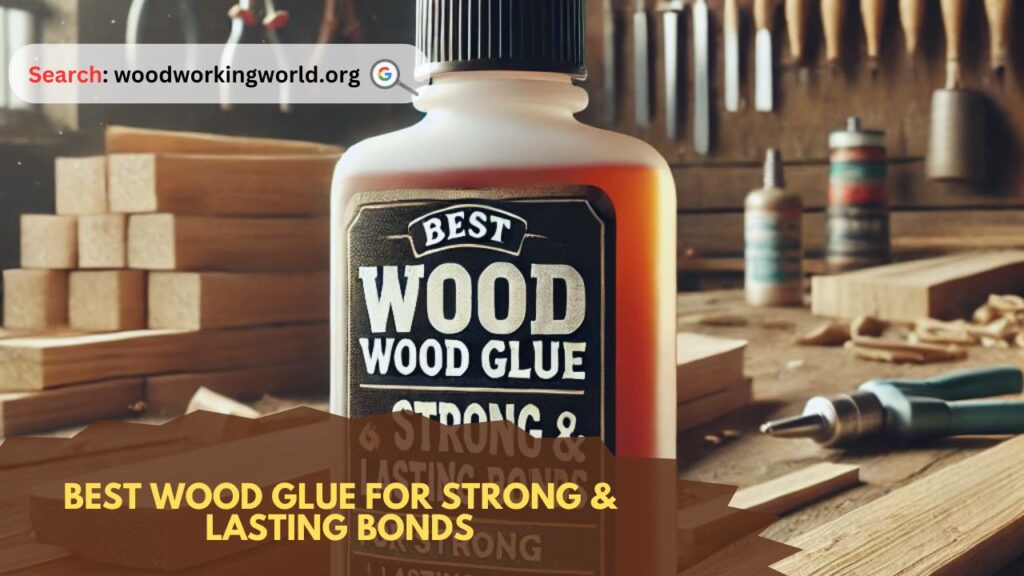Best Wood Glue for Strong & Lasting Bonds
Choosing the right wood glue can make a significant difference in the strength, durability, and overall success of your woodworking projects. With so many options available, it’s essential to understand which glue works best for different applications. In this guide, we’ll explore the top wood glues on the market and provide tips for selecting the perfect adhesive for your needs.

Top Wood Glues for Reliable Bonds
1. Titebond III Ultimate Wood Glue
Best For: Indoor and outdoor woodworking projects.
Key Features:
- Waterproof and FDA-approved for indirect food contact.
- Strong initial tack and fast set time.
- Excellent sandability.
Why It’s Great: Titebond III offers superior strength and weather resistance, making it ideal for both indoor and outdoor applications.
2. Gorilla Wood Glue
Best For: Heavy-duty woodworking and furniture assembly.
Key Features:
- Water-resistant (ANSI/HPVA Type II rated).
- Dries natural color.
- Strong bonding power.
Why It’s Great: Gorilla Wood Glue is known for its strength and versatility, performing well even in damp conditions.
3. Elmer’s Carpenter’s Wood Glue Max
Best For: Home improvement and DIY woodworking projects.
Key Features:
- Water-resistant and paintable.
- Non-toxic and easy to clean up with water.
- Bonds stronger than wood.
Why It’s Great: Elmer’s Carpenter’s Wood Glue Max is a reliable and affordable choice for DIY enthusiasts.
4. DAP Weldwood Original Wood Glue
Best For: Precision woodworking and cabinetry.
Key Features:
- Fast-setting and strong bond.
- Easy to sand and paint over.
Why It’s Great: DAP Weldwood provides a strong and durable bond, making it a go-to option for fine woodworking.
5. Franklin International Titebond II Premium Wood Glue
Best For: Exterior woodworking projects.
Key Features:
- Water-resistant (Type II water-resistant rating).
- Fast setting with a strong initial tack.
- Great for wood joints.
Why It’s Great: Titebond II is perfect for projects that may be exposed to moisture, offering excellent bonding strength.
Start Your Next Project With Teds’ Archive Of 16,000 Plans!
Instant access to all 16,000 woodworking plans with step-by-step details, photos, materials lists and more
Monthly free plans with lifetime membership access – No renewals, recurring fees or other charges


Factors to Consider When Choosing Wood Glue
1. Project Type:
- Indoor Projects: Look for PVA-based glues like Titebond or Elmer’s.
- Outdoor Projects: Opt for waterproof or water-resistant glues such as Titebond III or Gorilla Wood Glue.
2. Drying Time:
- Faster drying glues are ideal for quick assembly.
- For complex projects, use glues with longer open times.
3. Bond Strength:
- High-strength adhesives like epoxy are best for structural applications.
4. Compatibility:
- Ensure the glue is suitable for the wood type you’re working with.
5. Sandability and Paintability:
- Choose a glue that can be easily sanded and painted for a clean finish.
Pro Tip: Always test a small amount of glue on a scrap piece of wood to ensure compatibility and desired results.
Tips for Using Wood Glue Effectively
1. Surface Preparation:
- Ensure the surfaces are clean, dry, and free of dust.
- Sand rough edges for better adhesion.
2. Proper Application:
- Apply an even coat of glue using a brush or spreader.
- Avoid over-applying to prevent messy squeeze-out.
3. Clamping:
- Use clamps to hold the pieces together while the glue cures.
- Follow the manufacturer’s recommended clamping time.
4. Cleanup:
- Wipe away excess glue with a damp cloth before it dries.
- Sand any remaining residue after curing.
5. Allow Proper Curing Time:
- Be patient and let the glue fully cure for maximum strength.
Pro Tip: Label your clamps with drying times to avoid premature removal.
Comparison Table: Best Wood Glues
| Wood Glue | Best For | Water Resistance | Drying Time | Key Feature |
|---|---|---|---|---|
| Titebond III Ultimate | Indoor/outdoor projects | Waterproof | Moderate | FDA-approved for food contact |
| Gorilla Wood Glue | Heavy-duty woodworking | Water-resistant | Moderate | Strong bonding power |
| Elmer’s Carpenter’s Max | Home improvement projects | Water-resistant | Fast | Non-toxic and paintable |
| DAP Weldwood Original | Precision woodworking | Limited | Fast | Easy to sand and paint over |
| Titebond II Premium | Exterior projects | Water-resistant | Moderate | Great for wood joints |
FAQs
1. Can I use wood glue for outdoor projects?
Yes, but make sure to choose a water-resistant or waterproof glue such as Titebond III or Gorilla Wood Glue.
2. How long does wood glue take to dry?
Drying times vary by type. Some glues dry in as little as 30 minutes, while others may take several hours to fully cure.
3. How do I clean up wood glue?
Clean up wet glue with a damp cloth. Once dry, sand the area to remove any residue.
4. Can wood glue be painted over?
Yes, most wood glues can be painted over, but ensure they are fully cured and sanded for the best results.
5. What is the strongest wood glue?
Epoxy glues are typically the strongest, followed by polyurethane and high-quality PVA glues.
Video from a woodworking expert

Conclusion
Selecting the best wood glue for your projects can significantly impact the strength and longevity of your work. By understanding the different types of wood glue and their applications, you’ll be equipped to make informed choices and achieve professional-quality results. Keep this guide handy for your next woodworking adventure and experience the difference that the right adhesive can make.